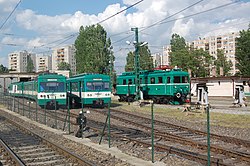HÉV
BHÉV
Railway network in and around Budapest, Hungary
BHÉV (Budapesti Helyiérdekű Vasút, "Budapest Railway of Local Interest") is a system of four commuter rail lines (Szentendre HÉV, Gödöllő HÉV, Csömör HÉV and Ráckeve HÉV) and rapid transit (Csepel HÉV and Békásmegyer HÉV (part of the Szentendre HÉV)) lines in and around Budapest, Hungary. The BHÉV operates on standard gauge (1,435 mm (4 ft 8+1⁄2 in) ), and is electrified at 1100 V DC.
This article needs additional citations for verification. (June 2023) |
You can help expand this article with text translated from the corresponding article in Hungarian. (June 2023) Click [show] for important translation instructions.
|
The BHÉV lines were constructed as branch lines of the Hungarian State Railways. Helyiérdekű vasút (HÉV), literally "railway of local interest", is a general term in Hungarian traffic. Therefore, like internationally with the term metro, the stations are only marked with H or HÉV, though this is not the full name of the system. The five BHÉV lines are operated by the public transport company MÁV-HÉV Zrt., a subsidiary of Hungarian State Railways. Inside Budapest, standard BKK tickets and passes are valid on the BHÉV. Outside Budapest, a separate ticket must be purchased.




